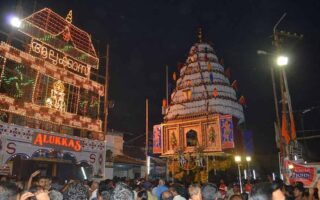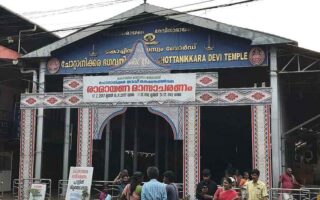- Dedicated to Lord Ayyappa: The temple is devoted to Lord Ayyappa, a revered deity.
- Seasonal Pilgrimage: The pilgrimage season runs from November to January each year.
- Ayyappan Devotees: Devotees, called Ayyappans, observe a 41-day penance before visiting.
- Challenging Trek: Pilgrimage involves a rigorous trek through forests and hills.
- Controversial Entry: Historic restrictions on women of menstruating age have sparked controversy.
- Massive Pilgrimage: Millions of devotees visit annually, making it one of the world’s largest pilgrimage sites.
- Makaravilakku Festival: The pilgrimage culminates in the grand Makaravilakku festival in January.
- Diverse Pilgrims: Sabarimala welcomes devotees from various backgrounds and beliefs.
- Serene Environment: The temple is nestled in lush greenery, providing a spiritually uplifting atmosphere.
- Timings: 05.00am to 10.00pm
- Entry Fee: No entry fee
This pilgrimage has a huge importance among the pilgrimages in the state of Kerala. The location of this pilgrim requires much effort of the devotees, because it is located on the rough Western Ghats. This spiritual pilgrim is committed to the major and very essential god of the Southern India’s people, Lord Ayyappa. It is over the sea level about nine hundred fourteen kilometers. It is spread over the broad Western Ghats. The Sabarimala village got this name as, it was derived from the character of Ramayana that is Shabri, she was a dedicated devotee of Lord Rama, she tried a lot to see Rama, her wish was got fulfilled and she got the opportunity to meet the Lord Rama. During the months of November to January, the major pilgrimage is undertaken. Here People from any religion can come and pray to god, that’s why without following any kind of religion, they prefer to wear a black color dhoti.

While going to the pilgrim, they pick up the some offering as per the ritual customs of Lord Ayyappa, which has religious material such as rice, coconut consisting ghee (butter) and camphor, all these materials are common factors which are used at temples. These rituals are done on the special occasion of the Sabarimala temple that is the Festival of the temple. All the devotees celebrate this festival on very large scale with full of enthusiasm. This is very essential Hindu temple of Kerala. This festival is celebrated in the respect of the Lord Ayyappan, people of entire India celebrate. When you go to the Sabarimala temple, don’t miss the two rituals or pujas which are performed in the pilgrimage, those rituals are such as Makar Sankranti Puja and Mandal Puja. These rituals are practiced during the months of November and January within Kerala. During this period, most of the devotees practice the attrition.
The History of Sabarimala Temple
The temple is dedicated to Lord Ayyappa, a deity believed to be celibate, and it has a unique set of traditions and practices associated with it. While the origins of the temple are somewhat shrouded in legend, it is widely believed to have ancient roots, with references to the temple dating back over a thousand years. Sabarimala gained prominence in the medieval period, attracting devotees from across India. The pilgrimage season typically falls between November and January and involves a challenging journey through the forested hills to reach the temple. One of the most distinctive features of Sabarimala was the ban on the entry of women of menstruating age, which persisted for centuries and sparked a heated debate until the Supreme Court of India lifted the ban in 2018, a decision that significantly impacted the temple’s history and traditions. The Sabarimala Temple remains a place of religious significance, attracting millions of devotees annually while continuing to evolve in response to the changing social and legal landscape.
Unique Features of Sabarimala Temple
The Ayyappa Deity
The presiding deity at Sabarimala is Lord Ayyappa, a unique and celibate god who attracts millions of devotees annually. The temple allows entry only to male devotees who have observed a 41-day penance and vow of celibacy.
Mandalapooja and Makaravilakku
The annual pilgrim season at Sabarimala begins with the Mandalapooja and culminates with the Makaravilakku festival. During this time, the temple is adorned with thousands of lamps, creating a mesmerizing sight.
Pilgrimage Restrictions
The temple enforces strict age and health restrictions, ensuring that only the physically fit can undertake the challenging trek to the shrine. Women of menstruating age were traditionally not allowed to enter, leading to significant controversy in recent years.

Sabarimala Temple’s Significance
Religious Importance
Sabarimala is not just a temple; it is a place of profound spiritual significance. Devotees believe that a pilgrimage to Sabarimala will cleanse their souls and bring them closer to Lord Ayyappa.
Cultural Significance
The temple’s rituals and traditions reflect the rich cultural heritage of Kerala. The temple is a hub of classical music, dance, and art, with various performances held during the pilgrimage season.
Rituals and Traditions
The pilgrimage to Sabarimala involves a series of rituals, including the ‘Irumudikettu’ offering, the 18 sacred steps, and the ‘Neyabhishekam’ ceremony. These rituals hold deep spiritual meanings for devotees.
Sabarimala Temple’s Architecture
The Main Temple
The Sabarimala Temple’s architecture is a fine example of Kerala style with intricate woodwork and art. The sanctum sanctorum houses the idol of Lord Ayyappa.
The 18 Holy Steps
The 18 sacred steps are a prominent feature of the temple, each symbolizing a different aspect of human life. Climbing these steps is an essential part of the pilgrimage.
Women’s Entry Controversy

The Sabarimala temple in Kerala, India, became the center of a contentious debate known as the “Women’s Entry Controversy” in 2018. This controversy revolved around the longstanding ban on women of menstruating age (10-50 years) from entering the temple, which was considered a tradition rooted in religious beliefs. However, in a historic decision, the Supreme Court of India, in September 2018, lifted this ban, asserting that it violated the constitutional rights of women. The decision led to widespread protests and sparked a divisive debate between those who saw it as a victory for gender equality and those who believed it encroached upon religious freedoms and traditions. The Sabarimala controversy exemplifies the ongoing struggle to balance individual rights with religious customs in India’s diverse and complex social landscape.
The Attrition
Devotees of the Lord Ayyappa go through the very difficult attrition, before starting to live in the Sabarimala pilgrimage. Devotees of this pilgrimage as per the tradition and customs wear the black color dhotis; they do work of the pilgrimage, indirectly to Lord Ayyappa. Sabarimala pilgrim is located on the Neeli hills, because of this, devotes which come to visit, have to climb this hill, with lots of efforts because they not just climb; they climb with all the ritual material. To cross such difficult and effortful distance, it requires almost three days. During this climbing, the very difficult and dangerous part is the last eighteen steps, which are joining the temple. Sabarimala pilgrim’s dome is designed in gold, normally before starting to climb, devotees believe in breaking the coconut, they believe this as a good fortune.
In the surrounding area of this pilgrimage, there is one Muslim mosque, which known as a Wavar. This temple is an associate of the Lord Ayyappa. The person who comes to this temple and making as a pilgrimage is called as Kanni Swamys and the person who comes with the group is called as Guru Swamy. During the climbing, devotees take a bath, in the Pamba River; people believe that all sins get immersed in the water of this river. To reach at this holy pilgrim, there are transportation mediums from the Pamba River. From this river, you have to cross about five kilometers distance to reach at this pilgrimage.
How to Plan Your Visit
Weather
Kerala enjoys a tropical climate, and Sabarimala is no exception. The weather can be divided into three main seasons: summer, monsoon, and winter.
- Summer (March to June): The weather is hot and humid during these months. Pilgrimage during summer can be physically challenging due to the heat.
- Monsoon (June to September): This is the rainy season, and heavy rainfall can make the pilgrimage difficult. Landslides and flooding are common in the region.
- Winter (October to February): This is the best time to visit Sabarimala. The weather is pleasant and cool, making the trek more comfortable.
How to Reach
Sabarimala is nestled in the Western Ghats and is accessible by road and rail.
- By Road: Devotees can reach Pamba, the base camp of Sabarimala, by road. From Pamba, it’s a steep trek of about 4-6 hours to the temple.
- By Rail: The nearest railway station is Chengannur, which is well-connected to major cities. From Chengannur, one can hire a taxi or take a bus to reach Pamba.
Best Time to Visit
The best time to visit Sabarimala is during the winter months, from October to February. The weather is pleasant, and the pilgrimage experience is more comfortable during this period.
Accommodations and Facilities
Sabarimala offers various accommodations for pilgrims, ranging from basic lodgings to comfortable guesthouses. These facilities ensure that devotees have a safe and comfortable stay.
Festivals at Sabarimala
Apart from the Makaravilakku festival, Sabarimala hosts several other festivals, including the Vishu Mahotsavam, Thiruvutsavam, and Onam. These celebrations add vibrancy to the spiritual atmosphere.
Conclusion
The Sabarimala Temple, nestled in the serene landscapes of Kerala, stands as a testament to faith, culture, and the power of unity. The temple’s rich history, rituals, and controversies make it a compelling destination for spiritual seekers, nature lovers, and cultural enthusiasts.
FAQs
Q-1: Can women of all ages visit Sabarimala now?
Following a legal battle and a Supreme Court ruling, women of all ages can now visit Sabarimala.
Q-2: What is the significance of the 18 sacred steps at Sabarimala?
The 18 sacred steps represent different aspects of human life and are symbolic of the spiritual journey.
Q-3: When is the best time to visit Sabarimala?
The peak pilgrimage season is from November to January during the Mandalapooja and Makaravilakku festivals.
Q-4: What is the dress code for Sabarimala?
Devotees are required to wear traditional attire, and men must follow the strict dress code.
Q-5: Are there any special precautions for the pilgrimage?
Pilgrims should be physically fit, carry essential supplies, and follow the prescribed penance and vows.


